Judy Nevin of San Antonio was concerned about Monarch chrysalises she’d been monitoring in her garden this week. One had crawled under some plant cloth and frozen when the temperatures dipped below 32. Another had relocated to a former basil plant and formed its green, gold-flecked container on a dead limb, perhaps to emerge on a day like those we experienced this weekend when the sun warmed parts of Bexar County to springlike temperatures in the 70s.
“I had two chrysalises until two nights before last,” said Nevin by phone. One froze and she brought the other inside.
Our schizophrenic weather, freezing one day and balmy the next, has provoked frequent questions from readers about what to do with chryalises found in the winter. Should you bring them inside? And why do they form away from their host plant?
Bringing a chrysalis inside for protection from the elements is a judgement call. We already covered the quandary of moving late season caterpillars indoors in this December post. The same logic applies to chrysalises. Will you be around to release the butterfly or do you plan to keep it inside if the weather is ornery? Do you have nectar for it–either artificial or natural? Depending on where you live and the time of year, the newborn butterfly may have few prospects for food or mating.
Again, there’s no “right” answer here.
As for caterpillars forming their chrysalises AWAY from their hostplants, this is common practice. We’ve brought hundreds of caterpillars and chrysalises inside, and yet it still provokes smiles when we find a chrysalis in an unlikely place.
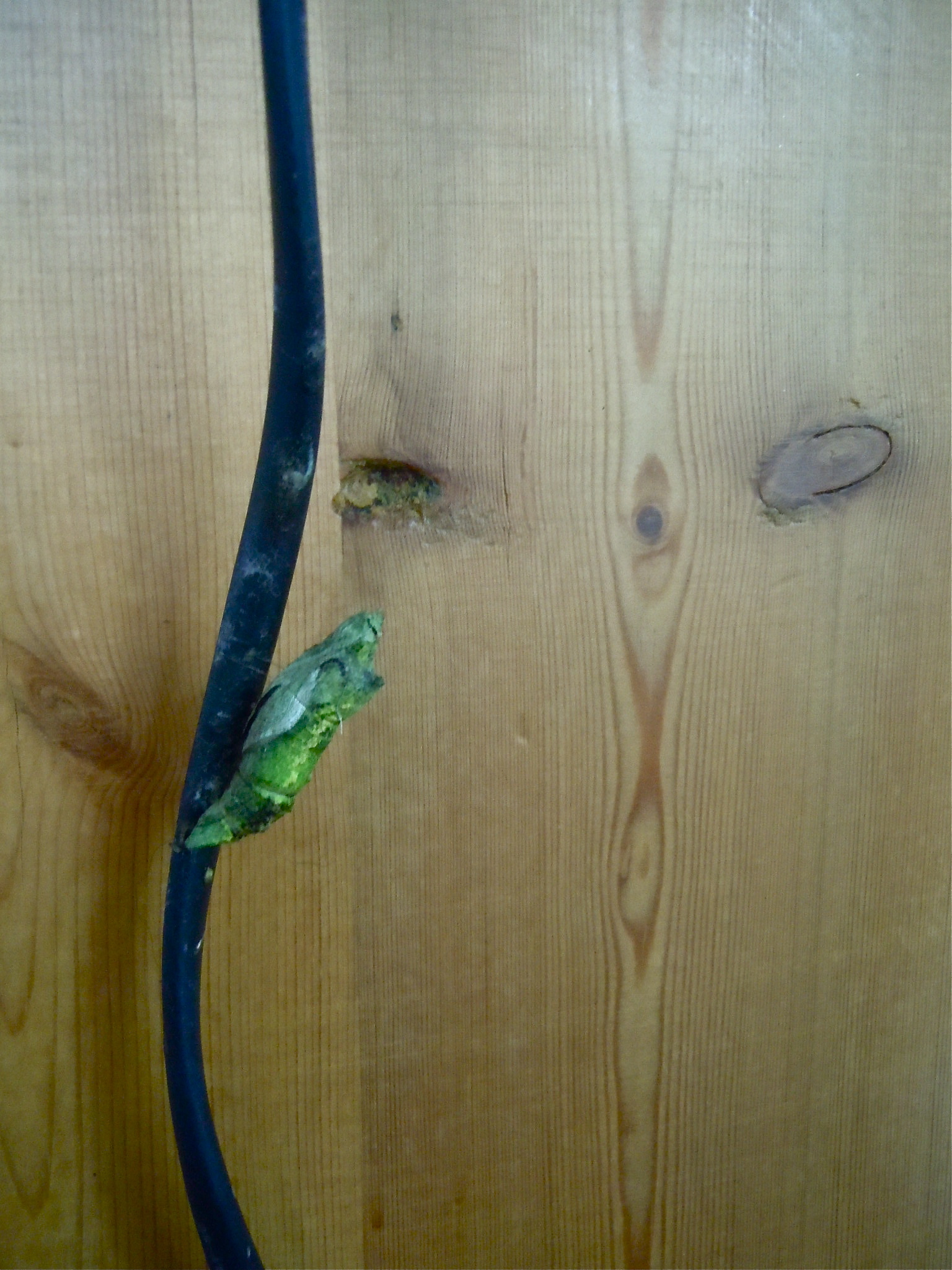
This Swallowtail wandered 25 feet from its host plant across a dining room to form its chrysalis on an electrical chord in a nearby bedroom. Photo by Monika Maeckle

Monarch chrysalis formed inside my hat! Photo by Mike Quinn
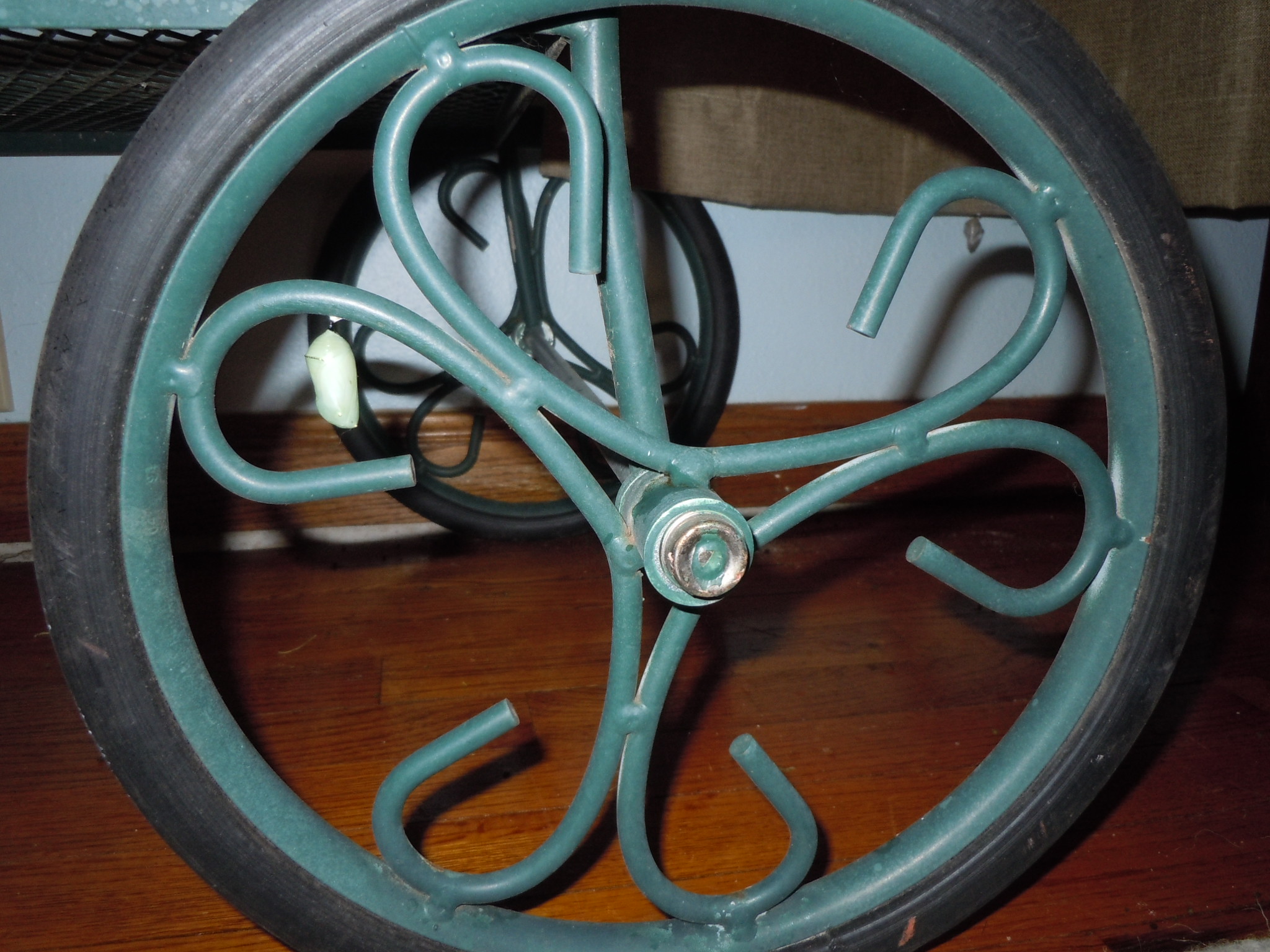
Wheels up! Monarch chrysalis formed on the wheel of this indoor garden cart. The caterpillar’s host plant was directly above the wheel. Photo by Monika Maeckle
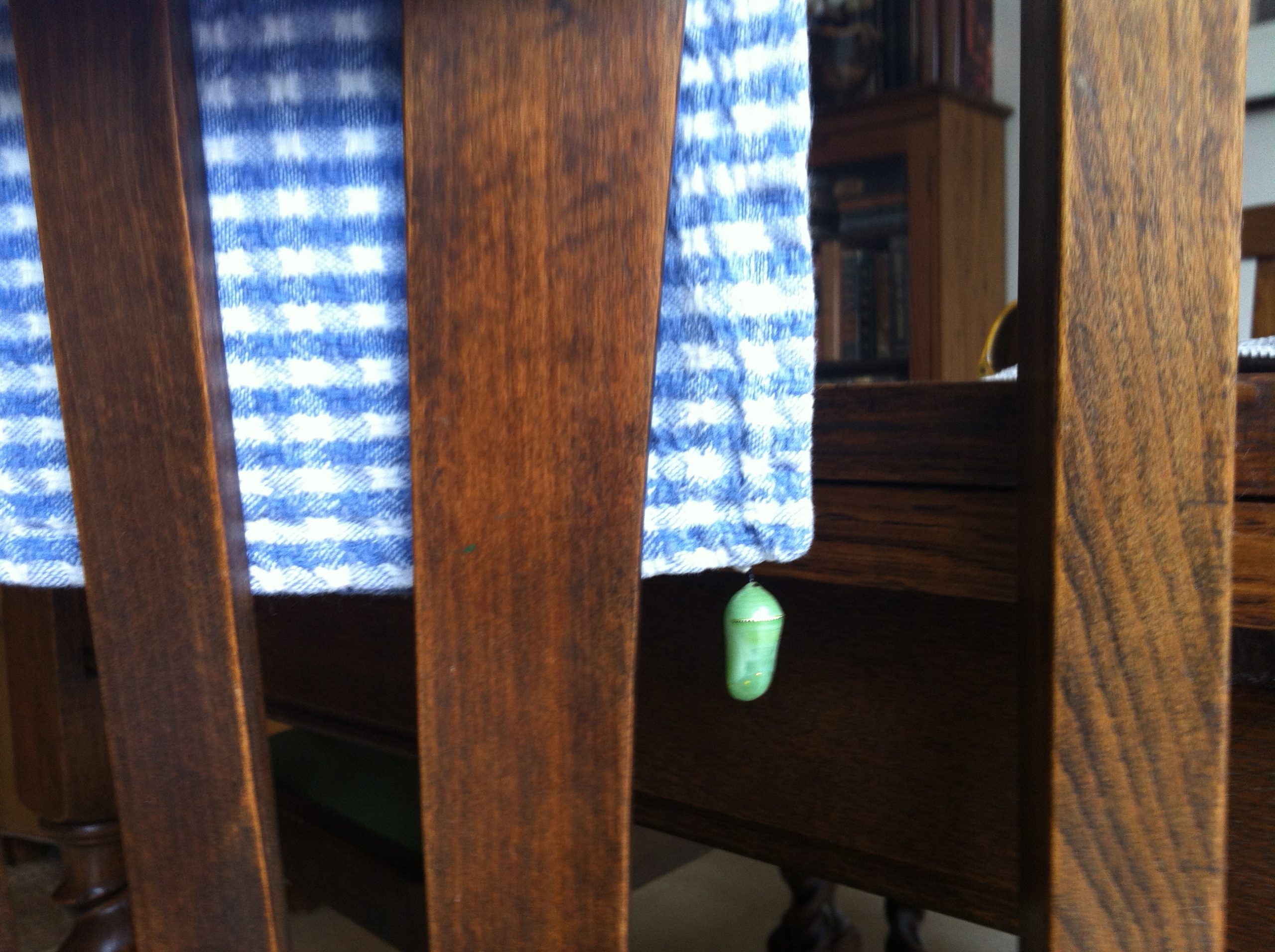
Monarch chrysalis formed on a napkin at my kitchen table. Photo by Monika Maeckle
We’ve found them under chairs, on curtains, napkins, blank walls, glass windows, and other unexpected locations.
Once a Swallowtail chrysalis wandered 20 feet from the host plant in my Austin apartment to form its chrysalis on the electrical chord of a flat iron.
Another time a Monarch caterpillar I was transporting to a speaking event in my car wandered away during the drive. Later I found the chrysalis inside my summer straw hat. I moved the perfectly formed chrysalis to a stick, tying its silk button with dental floss to a horizontal branch so it could hang vertically until it was ready to emerge. A week later, it did, nonplussed.
We’ve also made the dreary discovery of a perfectly formed dead butterfly that eclosed and was belatedly found–under a couch, near a window, or on the floor by a glass door when we were away for the weekend. A sad event, and something to consider should you bring in a chrysalis from the cold.
Why do these intriguing creatures wander so far from what they know so well and what has sustained them?
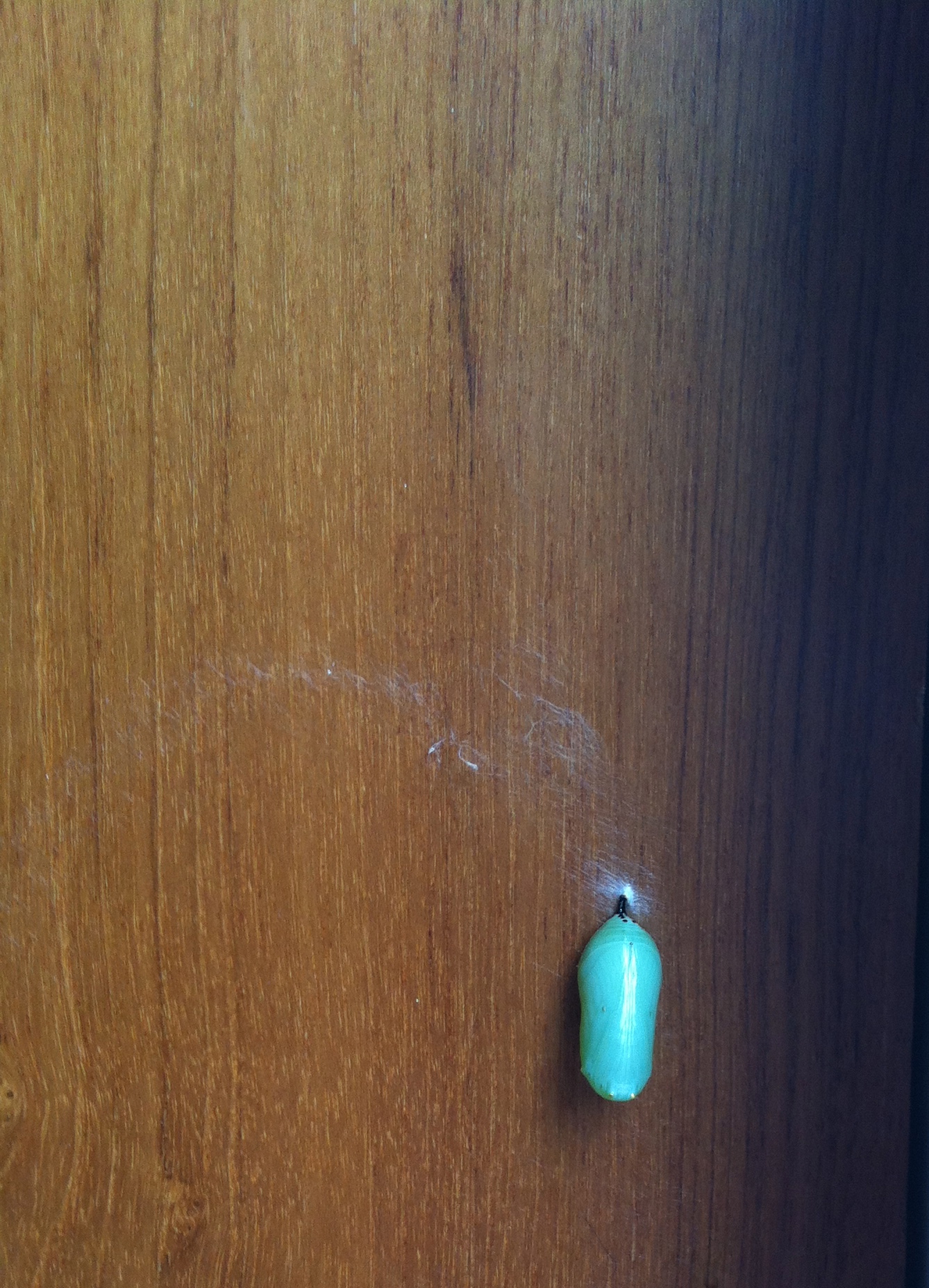
Monarch chrysalis on wall. Photo by Monika Maeckle
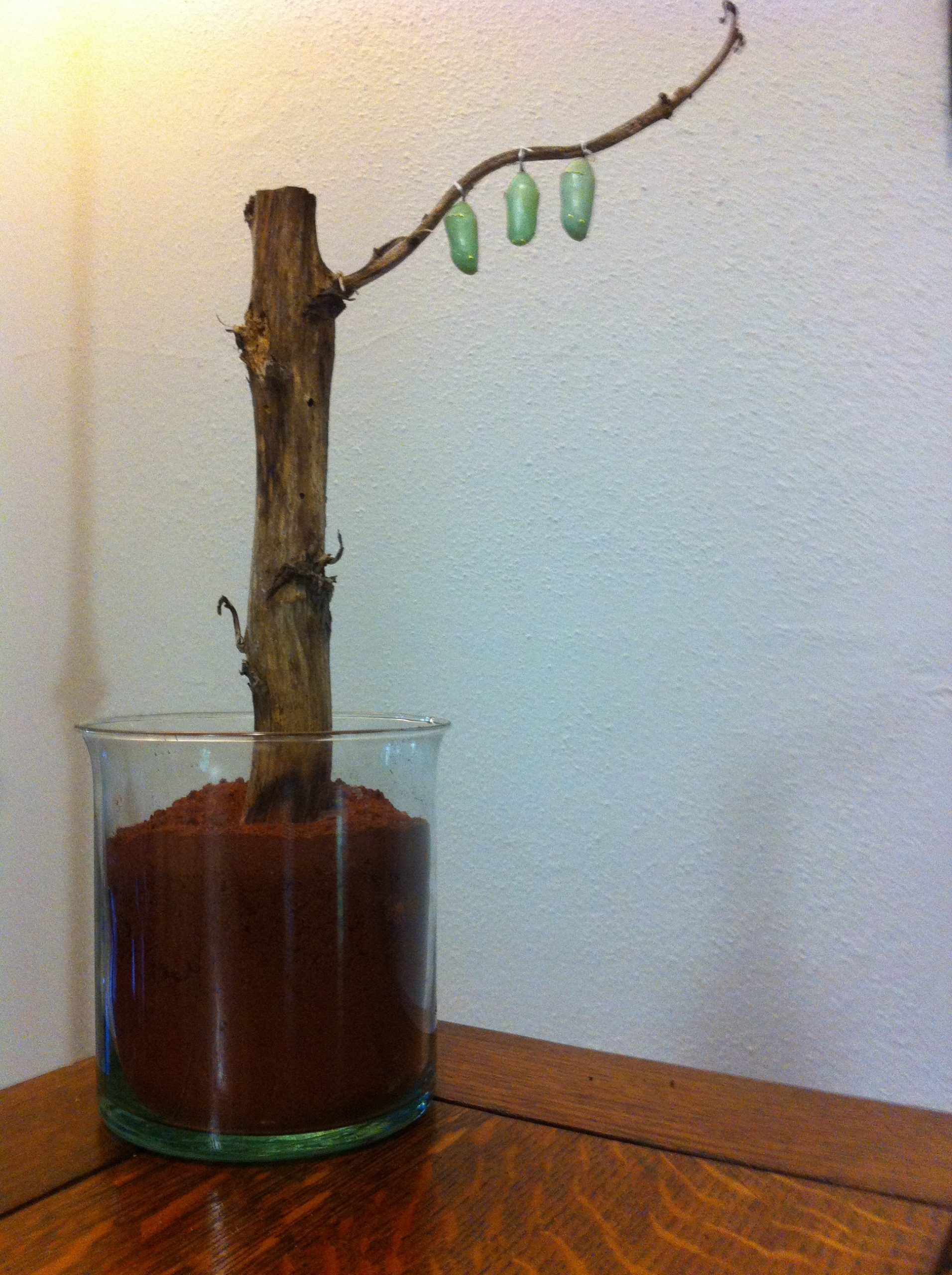
You can tie Monarch chrysalises onto a horizontal stick with dental floss to keep a close eye on them. Photo by Monika Maeckle
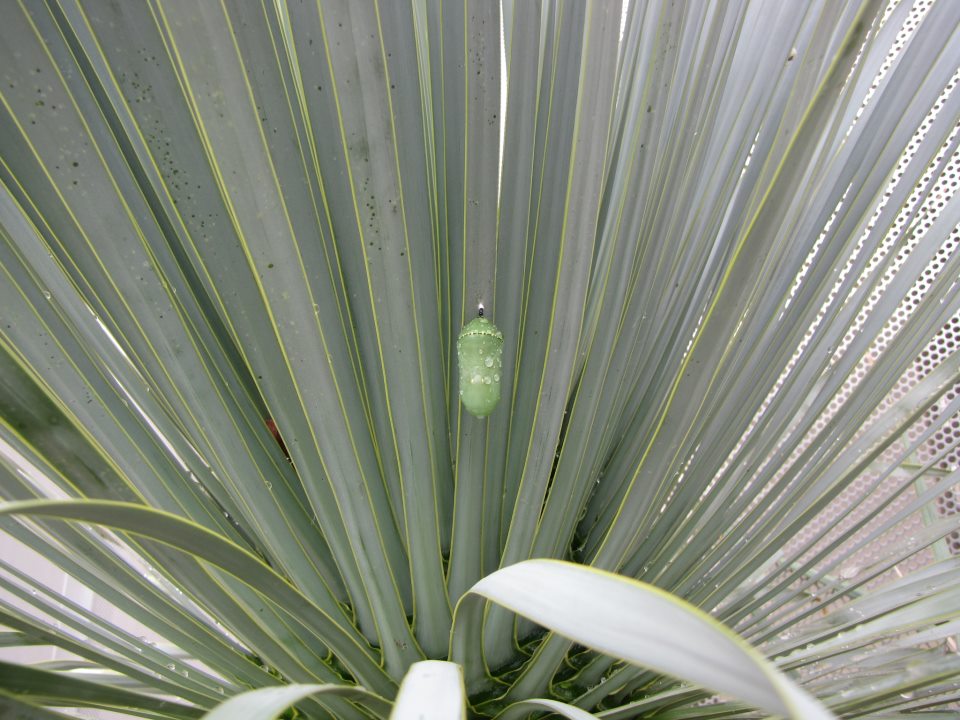
Safe place to form a chrysalis? We think so. Photo by Monika Maeckle
Scientists suggest this is a survival mechanism. If a caterpillar forms its chrysalis on the host plant and other caterpillars defoliate it, that leaves the chrysalis more visible and vulnerable to predators. My personal unscientifc theory is that caterpillars need a quiet spot to transform themselves into a completely different lifeform. Growing wings and planning your first flight must require deep concentration.
Like what you’re reading? Don’t miss a single article from the Texas Butterfly Ranch. Sign up for email delivery at the bottom of this page, like us on Facebook, follow us on Twitter, @monikam or on Instagram.

Great success, found a chrysalis on the ground, brought it inside & re-hung it with some dental floss. Was greeted with a perfect little butterfly this morning, so I’m very happy 🙂
Our Black Swallowtail caterpillar’s tail silk web was dislodged. It is hanging by the sling. Still in caterpillar form – not yet turned to chrysalis. Can the chrysalis be attached to the tree when hardened? If so, how? Please help!
Thank you!
I believe it can. Good luck!
I am amiss in not saying thank you earlier! I was able to reattach the chrysalis and it worked out just fine. I even wintered over several in the refrigerator, wrapped in a paper towel, and then hot glued them to wooden stakes in the spring and set them out in the flower window planter – all emerged just fine! Although each had their own ‘timing’ to emerge. Altogether, we ended up raising 50 monarchs and 20 swallowtails last year. So much fun!
Hi Ruth-
I just saw that you have successfully raised many butterflies and I am currently in a panic, because I have around 20 catapillars outside, at various stages, (and a couple crysalis) and it is going to freeze tonight. I want to bring them all in but I’m at a loss as to if they will have enough food and if they will make it in the winter months when they emerge into butterflies. I saw you recently posted and seem to know a lot about this. Any thoughts or ideas for me to do this?
I got this from another site that looks respectable: “If desired, you can move the pupa after it has formed. Wait until it is hard and dry (several hours or longer). Tie a piece of thread around the cremaster and with a needle or pin carefully tease away the silk that is holding the pupa to the surface. Leave the silk attached so the thread does not slip off (see figure below). If the pupa has fallen and there is very little silk remaining, add a drop of glue to the thread where it surrounds the cremaster. The loose ends of thread can then be tied through a hole in the container cover or through a space in the netting. Clothes pins can also be used to hold the loose end of the thread to a ring stand or other similar object. It is alright to handle the pupa carefully and even set it on a table for a minute. The pupa must hang, however, for the butterfly to form properly.” Good luck!
I have even used duct tape. It’s vexing sometimes to get them to hang when the silk is missing. Good luck!
I use a tiny drop of Elmer’s glue to fix the chrylsis to a jewelery tree. If the silk is missing, I lay down a q-tip
And set the chrylsis along side, gluing the very top to the cotton. When, dry, I hang it.
I found good info on monarchwatch.org: http://www.monarchwatch.org/rear/index.htm
More specifically: http://www.butterflyfunfacts.com/gluepupae.php
Hey, Ruth! I found another site that can help: https://texasbutterflyranch.com/2011/07/31/butterfly-faq-is-relocating-a-monarch-chrysalis-ok-yes-and-heres-tips-on-how-to-handle-them-with-care/
I enjoy reading all about butterfly ..
I am raising a monr arch from caterpillar
very helpful blog .
Hello!
I love your site. I was just wandering my “winter” garden here in LA, and was getting ready to cut back the milkweed for winter, and found 5 caterpillars crawling on the two plants. I’m a little at a loss, since I don’t think the plants have enough leaves. I am happy to bring them indoors, but do you have any thoughts for how to supply enough leaves? None of the local growers are carrying the tropical (or any other) milkweed.
This is frequently a late season challenge. You just have to make a call and do the best you can. If you bring them in they will have a better chance of survival but you may not have enough food for them to get huge. I have seen them go chrysalis much smaller than usual when food is scarce. They seem to know, and just make do, pupating smaller.
Sorry I wish I had a better answer. Nature is like that. Good luck!
That’s the smart thniking we could all benefit from.
Oops, my monarch caterpillar got out of the aquarium and is pupating under the fireplace. Guess I’ll leave him there.
Story: http://countrycitycindy.blogspot.com/2015/08/houdini-caterpillar.html
I have one Asclepias curassavica plant in my garden with five rapidly growing caterpillars on it. I’m not sure there will be enough food for all of them to mature?
Should I leave them alone or bring them inside? This was all a big surprise to me! I hope they will survive.
the catipilar i brout inside is in a cocoon he is on a dead milkweed leaf will he survive
What does it look like?
Yes, once in pupa stage, the caterpillar is no longer using the nutrition of the leaf. Keep it in a place where it continues to hang, it needs gravity to form its wings properly. Also, do not put it in front of anything hot or in direct sun. A bright area is best though. Once it emerges from the pupa, it will take several hours to dry its wings. in this time you may provide it a piece of cantaloupe or watermelon on a nearby plate. Provide nourishment until you release, which should be within 24 hours.
I have Eastern swallowtails that I read may overwinter, but- will they overwinter indoors or should I place the cage outside ? I’m concerned in warmer house temps they’ll hatch and the butterflies will not make it outdoors. Were in North Carolina and the temps are a hit or miss. Temps were down in low 50″s last week but are spiking again.
Hi everyone, one of my (very chubby) caterpillars fell – she was tweaking and secreting a green substance when I found her. I tried to put her back on the milkweed but she fell again. So, I created a small “clinic” for her in a box with fresh leaves and a stem. She ate a bit, and crawled unto the stem. She has been clearly lethargic for the last hours, but not “vomiting” anymore (she is still alive, I made sure). How can I help her? I did bring the plants from outside indoors, and bought new plants (I had to buy more! these caterpillars are voracious!)
Thanks for your feedback. =
Hi. My 2 swallowtail caterpillars have wandered away from their vase on the dining table. I found one climbing a basket but haven’t had luck finding the second one. Any tips on finding him?
They usually wander about 20 feet (or metres) away from their host plant so they wouldn’t (hopefully) be that far away. I think the best option is to wait for them to eclose and then fly our of wherever they were. If you do find them before that, then move them.
Hi, I live in Charleston, SC. 17 days ago I found around 16 monarch caterpillars on my milkweed. I have been continuously feeding them milkweed. They have not made a chrysalis yet. It has been in low 40’s at night and near 70 during the day. Wondering what they are up to?? How long til they chrysalis?
We brought a swallowtail caterpillar inside when 2 of it’s friends were made into dinner by our hens. I put it in a plastic Tupperware container and ordered a net butterfly terrarium. However, our caterpillar pupated before the terrarium arrived and the chrysalis is attached to the hard plastic. Several posted I read online said that our butterfly will not be able to properly emerge since she can’t climb the plastic. Any advice for how to make her enclosure more ideal? I have placed the Tupperware container inside the net enclosure, but I still don’t know how she’ll climb up the walls.
You can surround the chrysalis with paper towel or netting, something they can grab. Just tape it to the Tupperware. Otherwise, you can move the chrysalis to a more advantageous place. Use nontoxic glue to adhere to a stick or more friendly surface, and try to replicate the posture the chrysalis assumes in nature. Good luck!
Hi Monika, New to all things Buuterfly! Have three Black Swallowtail Caterpillars. Hatched on my Dill and Carrots. Plants are almost gone. I’m going to try to find more Dill plants at Nursery. I brought then inside because the first ones I found got eaten by something and only one survived to Butterfly. Question. Will the cooler inside AC temperatures in low 70’s effect them since they came from 80’s and 90’s outside? Will it slow down the process?
Thanks.
Alita Harris
I have found two black swallow tails that have seemed to pupate on top of one another and the weight has caused them to fall off the host plant..I brought them inside and put them in an enclosure and hung them but will they emerge alright being stuck together in opposite positions? Should and is it even possible to separate them without hurting them? Help?
Well, theres a link here. I think if the chrysalises are hardened (a few hours) then it should be safe to move them.
https://texasbutterflyranch.com/2011/07/31/butterfly-faq-is-relocating-a-monarch-chrysalis-ok-yes-and-heres-tips-on-how-to-handle-them-with-care/
There’s a link to make sure.
Good luck! (even though that was last year)
I brought home 5 4” Parsley plants from our local nursery. I had a total of 17 eggs on them. They all formed into tiny lil caterpillars within about 2-3 weeks.
Some did wander off, but, I found them b4 they pupated. When back safely inside the netted hamper w/netting across the top held onto hamper w/clothespins & potato chip clips, they all formed their chrysalises. I was SO surprised,…when, one morning, I awoke to a beautiful black, yellow & blue Swallowtail flitting about on my porch. I caught it & put it inside a large clear vase to which I added a couple of flowers from our yard. I also put a wet crumpledup paper towel inside the vase that I had put into a cup of warm water sweetened w/regular table sugar, (just in case the butterfly didn’t like the flowers I had put inside the vase!)
5 butterflies have emerged so far, one by one they are emerging on their own time schedule. There are 4 on the outside of the enclosure….1 on a small electric fan @ the bottom…nowhere near the blades!! It’s exciting to free them after they have been inside the vase for about one day. I let my granddaughter let one out into the yard & she thought that was pretty cool! I look foreward for her to be anle to release @ least a couple..or more…from the vase they stay in till ready for release into the fresh air!! Butterflies are so lovely to look @……& they do a great job pollinating!!
I just found (7/29) a swallowtail chrysalis hanging from a milkweed plant leaf (in Minnesota). Thinking that might not be the safest place for it I brought it home, wrapped the leaf around a twig so that it could hang and put it in a small critter cage that I use for Monarchs. I’m really hoping it will emerge in a timely fashion before winter comes. I’ve never had Swallowtails before.
Found 2 swallowtail caterpillars on my parsley plants 2 days ago. They are yellow, green, black and white. One just lost its skin yesterday. They are in a pot on the deck. I have wrapped the pot in netting for now, added some sticks and small branches. What is the next step so they can form to chrysalis? Undo netting and let them wander? Or should I contain them in same container, or a new one?
Thanks for any advice!!
I think one reason the caterpillar may wander away from the host was hinted at in the article. If there are enough caterpillars to defoliate the host, not only is it exposed, it may be nibbled on and damaged by the other caterpillars on the plant I had cannibalism in two cases the caterpillars in 5th instar munched on a brand new chrysalis that had not hardened yet. apparently it had the appropriate smell of ‘food’. This may or may not happen in the wild but if plants are scarce it may.. I misjudged the amount they would eat overnight, they ran out of leaves.
One of my monarch caterpillar made it’s chrysalis on the milkweed leaf. Should I just leave it there? It looks to be doing well so far. I am just an amateur at this
I live in Upstate NY. In late Summer-when I’m fortunate-I find several Eastern Black Swallowtail caterpillars on my fennel plants. Since the plants are near bird feeders most of them get eaten, so I pot a small fennel plant for food and put any caterpillars in a cage made of screen tops from aquariums and leave them on a shelf in the potting shed. When they’re ready they form their chrysalis. Even though our winters are brutal with snow, wind and temps near zero I leave them outside in their protected spot. Not sure if they would live, I left the door to the cage open anyway and sure enough, when Spring came they wiggle their way out as beautiful and healthy butterflies!
Do I need to mist the area where the chrysalis is if I have it in the house? I read I’m not supposed to mist the chrysalis directly.
I would, especially if your house is dry. You can also set houseplants near the chrysalis and mist those to keep the humidity up.
Hope that helps!